Related Research Articles
The Phoenix was an experimental version of the Bristol Aeroplane Company's Pegasus engine, adapted to run on the Diesel cycle. Only a few were built between 1928 and 1932, although samples fitted to a Westland Wapiti held the altitude record for diesel-powered aircraft at 27,453 ft from 11 May 1934 until World War II. The primary advantage of the Phoenix was better fuel efficiency at cruise, by up to 35%.

The Pratt & Whitney R-4360 Wasp Major is an American 28-cylinder four-row radial piston aircraft engine designed and built during World War II. First run in 1944, at 4,362.5 cu in (71.5 L), it is the largest-displacement aviation piston engine to be mass-produced in the United States, and at 4,300 hp (3,200 kW) the most powerful. It was the last of the Pratt & Whitney Wasp family, and the culmination of its maker's piston engine technology.

The Pratt & Whitney R-1535 Twin Wasp Junior was an engine used in American aircraft in the 1930s. The engine was introduced in 1932 as a 14-cylinder version of the 9-cylinder R-985. It was a two-row, air-cooled radial design. Displacement was 1,535 cu in (25.2 L); bore and stroke were both 5+3⁄16 in (132 mm).
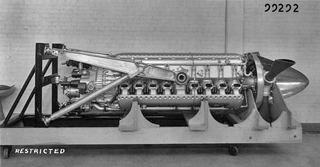
The Chrysler XIV-2220 was an experimental 2,500 hp, 2,220 cubic inch liquid-cooled inverted-V-16 World War II aircraft engine. Although several aircraft designs had considered using it, by the time it was ready for use in 1945 the war was already over. Only a few engines were built by Chrysler during a program that started in 1940, and it retained its 'X' designation the entire time as the XIV-2220, later XI-2220. The IV-2220 is historically important as it was Chrysler's first hemi, a design that would re-appear in 1950s Chrysler performance automobiles, make drag racing headlines in the 1960s, and continue into the 2000s.

The Klimov VK-107 was a V-12 liquid-cooled piston aircraft engine used by Soviet aircraft during World War II.
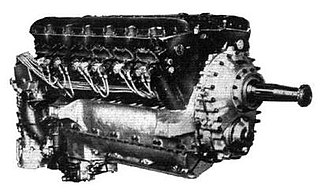
The Rolls-Royce Goshawk was a development of the Rolls-Royce Kestrel that used evaporative or steam cooling. In line with Rolls-Royce convention of naming piston engines after birds of prey, it was named after the goshawk.
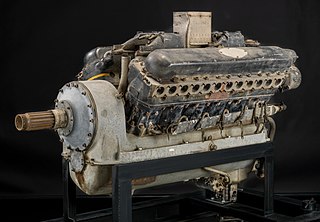
The Curtiss V-1570 Conqueror was a V12 liquid-cooled aircraft engine. Representing a more powerful version of the Curtiss D-12, the engine entered production in 1926 and flew in numerous aircraft.

The Allison V-3420 was a large experimental piston aircraft engine, designed in 1937 by the American Allison Engine Company.
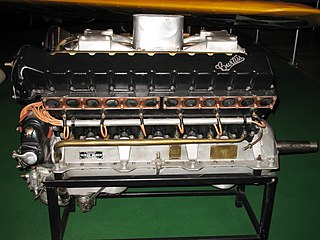
The Curtiss D-12, sometimes identified with the military designation Curtiss V-1150, was an aircraft engine of 18.8 liter displacement. It was a water-cooled V12, producing 443 hp (330 kW) and weighing 693 lb (314 kg). It was designed by Arthur Nutt in 1921 and used in the Curtiss CR-3 for the 1923 Schneider Trophy race. Fairey Aviation of England imported 50 Curtiss-built examples in 1926, renaming them the Fairey Felix.

The Continental XI-1430 Hyper engine was a liquid-cooled aircraft engine developed in the United States by a partnership between the US Army Air Corps and Continental Motors. It was the "official" result of the USAAC's hyper engine efforts that started in 1932, but never entered widespread production as it was not better than other available engines when it finally matured. In 1939, the I-1430-3 was designated as the engine to power the Curtiss XP-55, an extremely radical pusher-engine fighter design that would not reach production.

The Packard 1A-2500 is an American V-12 liquid-cooled aircraft engine designed by Packard in 1924 as a successor to the World War I-era Liberty L-12. Five aero variants were produced, of which the 3A-2500 was the most numerous. Three marine versions, used most prominently in American World War II PT-boats, the 3M-2500, 4M-2500, and 5M-2500, were also derived from it.
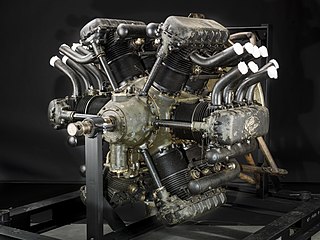
The Curtiss H-1640 Chieftain was an unusual American 12-cylinder radial aero engine designed and built by the Curtiss Aeroplane and Motor Company in the mid-1920s. In contrast to most multi-row radials, where the cylinders in the rows are staggered to present better airflow for cooling, the Chieftain used the inline radial arrangement with the cylinders behind each other to allow pairs of cylinders to share a cast cylinder head and camshafts. The design saw some use in the 1920s but was quickly passed by newer designs.

The RAF 3 is a British liquid-cooled, V-12 engine developed for aircraft use during World War I. Based on the eight–cylinder RAF 1 it was designed by the Royal Aircraft Factory but produced by the two British companies of Armstrong Whitworth and Napier & Son. The RAF 7 was a high compression version of the same engine.
The Fiat AS.5 was an Italian 12-cylinder, liquid-cooled V engine designed and built in the late-1920s by Fiat especially for the 1929 Schneider Trophy air race.

For the aircraft of the same name, see Fiat AS.2 (aircraft)

The Packard X-2775 was an American experimental liquid-cooled aircraft engine. The engine was constructed as a single crankcase with four banks of six cylinders in what is close to an X-configuration. The engine consisted of two 60° V12 engines, one upright and one inverted, sharing a common crankcase. Although technically incorrect, the engine has been characterized as two Packard 1A-1500 V-12 engines coupled with a mutual crankcase.
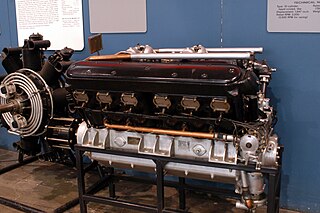
The Wright T-3 Tornado, also given the USAF designation Wright V-1950 was an American liquid-cooled aircraft piston engine, designed in the early 1920s.
The Franklin O-425 was an American air-cooled aircraft engine that first ran in the mid-1940s. The engine was of six-cylinder, horizontally-opposed layout and displaced 425 cu in (7 L). The power output was between 240 hp (179 kW) and 285 hp (213 kW) depending on variant. The O-405-13 (6V6-300-D16FT) of 1955 was a vertically mounted, turbocharged and fan cooled version for helicopters.
The Franklin O-405 was an American air-cooled aircraft engine of the 1940s. The engine was of six-cylinder, horizontally-opposed layout and displaced 405 cu in (6.64 L). The power output was between 200 hp (149 kW) and 250 hp (186 kW) depending on variant. The O-405-9 (6ACV-403) was a vertically mounted, fan cooled version for helicopters.
The Franklin O-540 was an American air-cooled aircraft engine that first ran in the early-1940s. The engine was of eight-cylinder, horizontally-opposed layout and displaced 540 cu in (9 L). The power output was nominally 300 hp (224 kW).
References
Notes
- ↑ Gunston 1989, p.109.
- ↑ Neal, Bob. "STATISTICS OF ALL THE AERO ENGINES OF PACKARD" (PDF). Aircrqaft Engine Historical Society. Washington D.C. Retrieved 20 January 2018.
Bibliography
- Gunston, Bill. World Encyclopedia of Aero Engines. Cambridge, England. Patrick Stephens Limited, 1989. ISBN 1-85260-163-9
- Aircraft Engine Historical Society